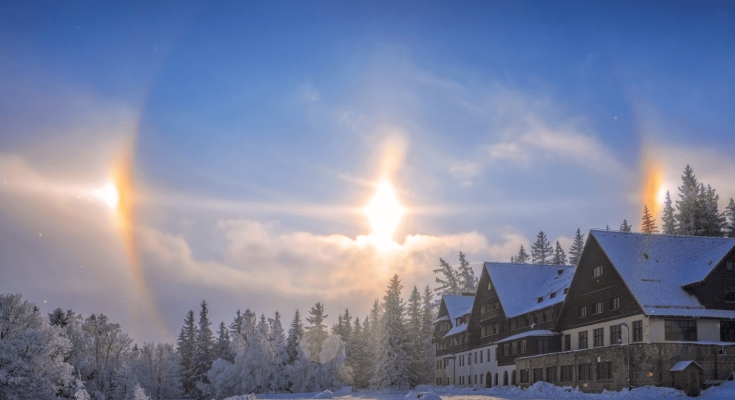What is parhelion? Understanding the “false sun” phenomenon
Parhelion, commonly referred to as a “sundog,” is an optical phenomenon that causes the appearance of one or more bright spots around the sun. These spots can look like extra suns, creating the illusion of two or three suns in the sky.

The basics: The term “parhelion” comes from the Greek words “para” (beside) and “helios” (sun), which together mean “next to the sun.” Parhelia typically appear as bright, rainbow-like patches to the left and right of the sun, often forming a halo-like arc.
Optical illusion: Although parhelia may look like multiple suns, they are merely reflections or refractions of sunlight. These reflections occur when light passes through ice crystals in the atmosphere, causing a visual trick that makes it look like there are additional suns.
How do parhelions form? The science behind the “three suns”
The parhelion phenomenon occurs due to the unique interaction between sunlight and ice crystals in the upper atmosphere. Here’s how it works:
Ice crystals in the air: Parhelia form when numerous ice crystals are suspended in the atmosphere. These ice crystals are mostly hexagonal and are found in high-altitude cirrus clouds.
Refraction of light: When sunlight passes through these ice crystals, it is refracted at specific angles (usually around 22 degrees). This refraction causes the light to scatter and form a bright spot next to the sun, creating the sundog effect.

Environmental Conditions: For parhelion to be visible, the air must be cold and saturated with moisture, which leads to the formation of ice crystals. This is why sundogs are more common in colder regions or during the winter months when ice crystals are more abundant in the atmosphere.
The Role of Cirrus Clouds: The Perfect Canvas for Parhelion
Cirrus clouds play a crucial role in the formation of parhelion. These thin, veil-like clouds are made up of tiny ice crystals and are ideal for the creation of optical phenomena such as sundogs.

Characteristics of Cirrus Clouds: Cirrus clouds are high-altitude clouds, often at an altitude of 20,000 feet or more. They appear thin and feathery, resembling silk or cotton threads stretching across the sky.
Prism Effect: The ice crystals in cirrus clouds act like small prisms. When sunlight hits these prisms, the light is refracted and redirected, creating bright, colored patches that mimic the sun’s beam. The result is the illusion of multiple suns in the sky.
Viewing conditions: Parhelion is best seen when cirrus clouds are relatively dense and close to the sun. The phenomenon is also more visible when the sun is lower on the horizon, typically at sunrise or sunset.
